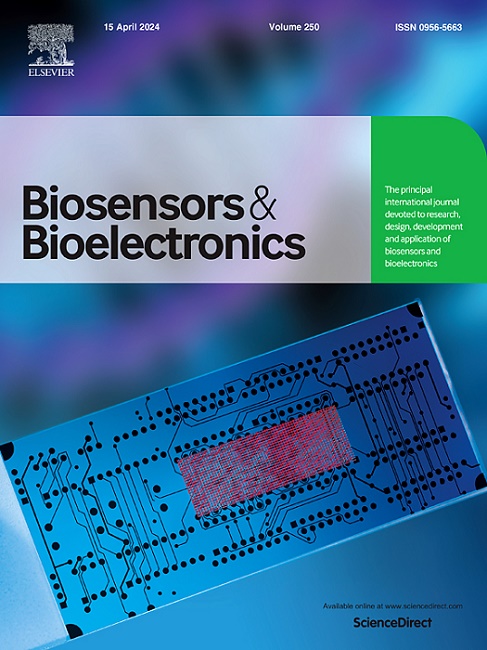An integrated wearable photo-electrochemical sensor for visible light amplified uric acid monitoring in sweat
IF 10.5
1区 生物学
Q1 BIOPHYSICS
引用次数: 0
Abstract
Uric acid (UA), a crucial biomarker for chronic metabolic disorders such as gout and hyperuricemia, necessitates non-invasive monitoring for effective disease management. However, wearable sensor for real-time UA detection face significant challenges due to the low UA concentration (<100 μM) in human sweat and the difficulty of multi-functional integration. Here, we developed an integrated wearable photo-electrochemical (PEC) sensor for UA detection in sweat. The sensor comprises iontophoresis electrodes, micro-channel, PEC detection unit and signal system, successfully integrating the functions including the sweat induction, sample collection, visible light amplified UA detection, as well as signal processing and wireless communication. With the ion-doping and Z-scheme heterojunction effect, the In doped ZnS/reduced graphene oxide/BiVO4 (ZIS/RGO/BVO) modified enzymatic working electrode facilitates the photo-generation and separation of the electron and holes, leading to an excellent PEC response under the visible light irradiation. The resultant sensor demonstrates exceptional performances with a sensitivity 280 μA mM−1·cm−2, a limit of detection (LOD) 0.23 μM (S/N = 3), and a broad linear range from 10 to 450 μM respectively. This integrated wearable sensor establishes a paradigm for sweat-based metabolic monitoring, showing remarkable potential for the personalized diagnosis of gout and hyperuricemia.
一种集成式可穿戴光电电化学传感器,用于放大汗液中尿酸的监测
尿酸(UA)是痛风和高尿酸血症等慢性代谢性疾病的重要生物标志物,需要进行无创监测以实现有效的疾病管理。然而,由于人体汗液中UA浓度较低(<100 μM),且难以实现多功能集成,因此用于实时UA检测的可穿戴传感器面临重大挑战。在这里,我们开发了一种集成的可穿戴光电电化学(PEC)传感器,用于汗液中的UA检测。该传感器由离子电泳电极、微通道、PEC检测单元和信号系统组成,成功集成了汗液感应、样品采集、可见光放大UA检测、信号处理和无线通信等功能。通过离子掺杂和Z-scheme异质结效应,In掺杂ZnS/还原氧化石墨烯/BiVO4 (ZIS/RGO/BVO)修饰的酶促工作电极促进了电子和空穴的光生成和分离,在可见光下具有优异的PEC响应。该传感器的灵敏度为280 μA mM−1·cm−2,检测限(LOD)为0.23 μM (S/N = 3),线性范围为10 ~ 450 μM。这种集成的可穿戴传感器为基于汗液的代谢监测建立了一个范例,显示出痛风和高尿酸血症个性化诊断的巨大潜力。
本文章由计算机程序翻译,如有差异,请以英文原文为准。
求助全文
约1分钟内获得全文
求助全文
来源期刊

Biosensors and Bioelectronics
工程技术-电化学
CiteScore
20.80
自引率
7.10%
发文量
1006
审稿时长
29 days
期刊介绍:
Biosensors & Bioelectronics, along with its open access companion journal Biosensors & Bioelectronics: X, is the leading international publication in the field of biosensors and bioelectronics. It covers research, design, development, and application of biosensors, which are analytical devices incorporating biological materials with physicochemical transducers. These devices, including sensors, DNA chips, electronic noses, and lab-on-a-chip, produce digital signals proportional to specific analytes. Examples include immunosensors and enzyme-based biosensors, applied in various fields such as medicine, environmental monitoring, and food industry. The journal also focuses on molecular and supramolecular structures for enhancing device performance.
 求助内容:
求助内容: 应助结果提醒方式:
应助结果提醒方式:


